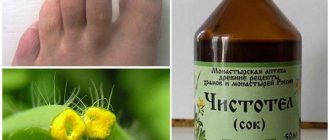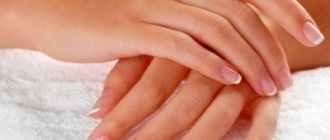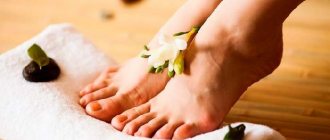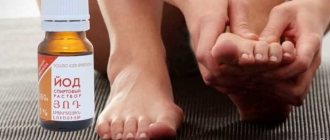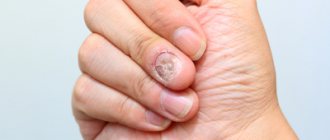The article was prepared by a specialist for informational purposes only. We urge you not to self-medicate. When the first symptoms appear, consult a doctor.
Fingernail fungus is an infectious lesion of the nail plate, which is provoked by pathogenic and opportunistic fungi.
According to available statistics, onychomycosis of the hands is caused primarily by yeast-like fungi of the genus Candida (in 44.5% of cases), followed by fungi of the dermatomycetes group (up to 36.4% of cases), mold fungi (16.5%) and other mycotic organisms (up to 0.5%). Hand fungus can affect either one or several nail plates, and parallel damage to the fingernails of the lower extremities is possible.
Clinical observations indicate that the number of people suffering from fingernail fungus is increasing every year, which is explained by the factor of intrafamily infection. Experts point to an increased number of patients with mixed non-dermatophyte flora on the nails. Thus, mixed flora occurs in 7.3% of cases. This is a rather dangerous trend, since there is an opinion that mixed non-dermatophyte fungi can increase sensitization of the human body.
The number of people with fungal nail infections, according to various sources, varies from 2% to 18.5% of the general human population.
What is the danger?
Without treatment, a fungal infection can serve as an “entry gate” for infectious diseases, such as erysipelas. The worst thing is that in many patients this process sooner or later moves from the feet to the hands. This is a real tragedy for women. If your toenails can be hidden in shoes or socks, then your hands are always visible. Extending nails, using polish, etc. only worsens the process. Such tricks form the so-called “greenhouse effect” and the fungus begins to feel just great, multiplying and destroying your nails, health and peace of mind.
Unfortunately, once the fungus has taken root, it will never leave its host without treatment. The process can only progress and spread to other parts of the body. So, itchy, scaly spots may appear in the groin area, head, thighs and other parts of the body.
We should not forget about the constant allergization of the body, weakening of the immune system, exacerbation and worsening of chronic diseases such as diabetes and bronchial asthma.
Diseases with similar symptoms
Of all infectious diseases, onychomycosis occurs in 50% of cases. Similar symptoms occur in the following diseases:
- Eczema.
- Psoriasis.
- Reiter's syndrome.
- Darier's disease.
- Lichen planus.
- Pachyonychia.
- Lichen planus.
- Norwegian scabies.
Rice. 12. Nail damage due to psoriatic arthritis.
Rice. 13. The photo shows green nails. Onychia pseudomonas. The disease is caused by the colonization of Pseudomonas aeruginosa in the cavities under the nails.
Rice. 14. The photo shows nails after chemotherapy.
Rice. 15. The photo shows the appearance of nails after injury.
Not necessarily a fungus
In addition to mycosis, there are many other diseases that affect the nails. Among them, it should be noted in particular onychodystrophy, psoriasis of the nail plates, eczema of the nail plates, etc. Their treatment is radically different from the treatment of fungus. To confirm and establish an accurate diagnosis of onychomycosis, it is necessary to do tests: microscopy and culture. These methods make it possible to identify the exact type of fungus: dermatophytes, mold or yeast. Now many doctors neglect this, and completely in vain. The prescription of the necessary treatment and the selection of the correct systemic therapy depend on the type of fungus.
What is the source of infection
- Diseases in your family and friends can become a source of pathogens for you too. The fungus is transmitted within a family through the use of shared towels, bed linen, etc.
- Fungus on the skin and nails of the feet can become a source of onychomycosis of the hands.
- The fungus lives in large quantities in bathhouses, showers and swimming pools.
- The source of fungi can be the patient’s clothes and shoes, manicure sets, carpets and floors.
Rice. 3. The photo shows fingernail fungus.
Details about diagnostics
In some cases, in addition to examination and microscopic examination, additional tests may be needed. So, in especially advanced or difficult to diagnose cases, the patient needs to check the function of the liver and kidneys. To do this, you need to donate blood for biochemistry: apartate aminotransferase and anine aminotransferase, creatinine. It is also necessary to exclude hepatitis B and C. Only based on these tests (biochemistry, microscopy and culture), it is possible to prescribe the correct therapy for the patient, which will get rid of the problem once and for all and will not harm the patient. Once every 1.5 months, a biochemical blood test is repeated to monitor drug tolerance. Most often, everything remains normal, but in rare cases of an individual reaction, an increase in indicators may occur. In this case, hepaprotectors are prescribed, the dosage or frequency of administration is reduced, or a lighter drug is prescribed.
Is there a universal treatment for onychomycosis?
Despite the complexity of fighting fungal diseases, there is a universal remedy that helps with any type of nail fungus - the PACT Med method. This method of getting rid of onychomycosis was invented by German scientists. The method works as follows: using a special apparatus, the affected areas of the nail are exposed to light waves; in this case, the fungal cells, pre-treated with a special gel, die, while the healthy cells of the body remain safe and sound.
PACT Med helps with all types of fungus. If onychomycosis of nails is still in the initial stage, then three sessions are enough. In advanced cases, the number of sessions is determined by a mycologist.
If you now suspect that you are developing nail onychomycosis, do not try to forget about the problem and do not self-medicate. Take a scraping for the fungus - and you will find out for sure whether you have the disease or not. Knowing the enemy by sight, you will get rid of him faster, and if your assumptions are not confirmed, you will breathe freely and stop tormenting from far-fetched fears.
Sign up for testing by phone. +7 963 964-79-76 (free call within Russia) or leave a request on the website.
Is it really being treated?
Today, the problem of successful therapy of mycoses can be solved. But it must be approached professionally. One of the important points: in addition to drug treatment, hardware treatment with diamond cutters is strongly recommended for patients with nail mycoses. Its essence is to remove as much as possible the part of the nail affected by the mycelium of the fungus, for better penetration of external therapy drugs and speed up recovery. It should be borne in mind that, unfortunately, neither ointments nor solutions penetrate the nail. If you do not remove several layers of the nail plate affected by mycelium, then during the growth of a healthy nail, it will be re-affected by screening from the infected part of the nail plate.
Signs and symptoms of disease of the nail plate and the skin around it
The initial stages of nail fungus do not always begin to appear directly on the nail plate. Often the pathology manifests itself:
- excessive dryness of the skin of the hands;
- itching;
- presence of cracks;
- redness or inflammation.
Signs of fungal infection may also
- bubble formations between the fingers;
- discomfort and burning sensation in the nail plate area;
- redness of the nail fold;
- the presence of pus in the wounds between the fingers.
Important . The first symptoms are often mistaken for allergic reactions. Meanwhile, the infection spreads further and quickly affects the nails.
The nail plate changes color and turns from pink to cloudy and dull. Yellow or white spots appear along the edges or at the base, which quickly spread over the surface of the nail.
All symptoms of fungus depend on the specific type of pathogen, so before starting treatment, you need to know the form of mycosis.
Signs of mycosis on the nails appear:
- the appearance of spots, grooves and stripes on the nails;
- sharp thickening of the structure;
- color change;
- unnatural convexity or retraction of the nail plate into the bed;
- partial or complete detachment of the nail plate;
- brittleness and looseness of nails.
Recovery time
In the most severe cases of long-term, advanced mycosis, the average duration of therapy will take 6-7 months. This period of time is determined by the rate of growth of toenails - the nail plate completely changes just during this time. This period does not mean that the patient will need to regularly visit the doctor for the entire six months. Scheduled follow-up visits to the doctor are necessary only 2-3 times during therapy, including the initial appointment (now we are not talking about visits for a hardware pedicure procedure).
Causes and risk factors
The etiology of the disease is based on infection of the nails by pathogenic fungi, including:
- dermatophytes (T. rubrum, T. interdigitale);
- yeast of the genus Candida (C. aibicans, C. tropicalis);
- mold fungi (Fusaria, Alternaria).
In addition to the main cause of the disease, there are a number of predisposing factors that increase the risk of developing onychomycosis. The trigger for the activation of a fungal infection can be:
- lack of nail care;
- diabetes;
- varicose veins;
- obesity;
- injuries;
- wearing tight shoes;
- poor quality pedicure;
- taking potent drugs.
Particular attention in the development of the disease is given to the state of the immune system. With strong immunity, the human body will be able to resist pathogenic flora even after it penetrates the body, but if immunity is reduced, fungal mycelium easily penetrates the epithelium of the nail, which causes inflammatory and dystrophic changes.
Nail fungus should not be considered as an aesthetic problem, since the toxins released by fungi can spread throughout the entire body and cause a number of concomitant diseases.
Photo: Symptoms of fungal nail infection
Case study
Patient A. came for an initial appointment in November 2009 with complaints of changes in the structure and color of nails, itching in the groin area. He has been ill, according to him, for about six years. Treatment with Orungal, Lamisil and Batrafen Lac did not bring relief. The patient experienced great anxiety and even despair when the process moved to his fingernails, which became the decisive impetus for visiting the mycologist. Upon examination, the nails of A.'s big toes are completely affected: thickened, crumbling, yellow in color. Detachment of the epidermis, itching, and cracks in the skin between the fingers were also observed. On the first and fifth fingers of the right hand there are yellow spots, thickening and detachment from the nail bed. Inguinal region: large, clearly defined scaly plaques, excoriations.
At the beginning of December, the results of A.'s tests were completely ready. Using an accurate history, physical examination and laboratory methods, eczema, onychodystrophy, psoriasis of skin folds, erythrasma and candidiasis of skin folds - severe skin diseases with identical external signs - were excluded. To confirm the fungal etiology of this process, material was taken from the nail plates and the skin of the groin area. In both cases, microscopy revealed fungal mycelium, and the exact pathogen was identified in culture - Trichophyton rubrum.
Already at the first examination, it became obvious that for a successful recovery the patient needed a therapeutic spectrum, including broad external therapy, therapy with systemic antimycotics, and therapy for dystrophic processes in the nail bed that arose as a result of the duration of the disease. In addition, recommendations were given aimed at improving microcirculation and improving blood flow to the nail plates, which should ensure the delivery of the necessary nutrients, also prescribed to accelerate nail growth and reduce treatment time.
The third visit was scheduled for A. at the end of February. Upon examination, a significant improvement in condition was observed. So, in particular, in the groin area the skin is absolutely healthy, blood biochemistry tests are normal. The treatment regimen has been adjusted (in the process this must be done once every two months).
The last visit took place at the end of April 2010. Based on the results of the examination and repeated tests (blood biochemistry and microscopy), patient A. is absolutely healthy.
How to treat fingernail fungus at home
Official medicine is suitable for exacerbation of onychomycosis. But maintenance therapy will be needed for a long time to consolidate the achieved results. Here, many people-tested methods from products that are always at hand will come to the rescue.
Coffee
Treatment of fingernail fungus can begin with the use of ordinary coffee. Soluble will not work. You need to take only natural whole grains and grind them yourself. Coffee contains tannins, antioxidants and other beneficial components that can speed up tissue repair and strengthen local immunity.
Five tablespoons of coffee are brewed in a liter of boiling water, cooled to a temperature that can be withheld (about 40 degrees). The drink is poured into a container in which it will be convenient to hold your hands for about 15 minutes. It is important that the fingers are completely covered. After the bath, an anti-fungal agent is applied to the dried fingers.
The only downside to using coffee is that the skin may darken, but it quickly restores color after stopping treatment.
Tea mushroom
A neglected fungus is popularly treated with kombucha, which contains gluconic, lactic, acetic acids, caffeine, B vitamins, as well as C, D, PP.
Bring a two-month old infusion of kombucha to a boil, hold on low heat for an hour, turn off, strain, cool. The resulting solution is equivalent in quality to five percent vinegar.
Soak a clean cotton cloth in the kombucha solution, apply it to your nails, secure, and leave overnight. After a few days, the affected part of the nail plate will soften enough to cut it off with nail scissors.
Kombucha is recommended for external use only.
Egg
A combination of vinegar and egg helps get rid of nail fungus. Regular use of vinegar neutralizes the effect of the fungus, and the egg, which contains lecithin, vitamins, and microelements, helps restore it.
A fresh egg is poured with 100 ml of vinegar essence and left in the dark until the egg shell disappears. Then the film is removed from the egg and the contents are mixed with 100 g of melted butter. The resulting product is applied to tissues damaged by the fungus twice a day, wrapped in cling film.
Vinegar
You can remove fungus at home with vinegar. It creates an environment around the nail in which the parasite cannot reproduce. Treatment procedures are repeated until complete recovery. However, you need to be careful not to get burned.
A pack of dried celandine should be filled with a liter of apple cider vinegar and four tablespoons of salt added. Leave for 3 weeks. Use the resulting solution for baths every evening. The duration of the bath is at least 10 minutes.
Since vinegar is a powerful antiseptic, the same solution can be used repeatedly without fear of re-infection.
Lemon
An excellent recipe for fungus with lemon and turmeric is easy to prepare at home. Citric acid has medicinal value, it removes fungus and whitens the nail plate. Turmeric takes part in the restoration of the skin on the fingers.
A little pure lemon juice is mixed with turmeric until the ointment becomes smooth. The ointment is applied to the nails every day for a week.
Essential oils
Treatment of onychomycosis in the early stages is carried out with essential oils. Oregano or oregano oil heals wounds and relieves skin inflammation, rosemary oil strengthens nails, fir oil disinfects and relieves pain, cinnamon oil improves blood circulation.
The longest effects of essential oils are achieved with compresses. A cotton pad is moistened with a few drops of different oils, applied to the affected nail, and fixed with a band-aid. These compresses are best done at night.
Medicinal herbs
In a couple of months, medicinal herbs that are suitable for external and internal use get rid of the fungus.
Echinacea is infused in vodka for 4 weeks. 30 drops of tincture are diluted in 50 g of water, drunk half an hour before meals, twice a day. You need to take the medicine for 3 weeks, then a 2-week break.
To prepare an external ointment, take thyme and calendula in equal proportions and grind them into powder. One part of the powder is mixed with four parts of Vaseline. The resulting ointment is applied to the area damaged by the fungus twice a day.
Garlic
The fastest way to cure onychomycosis is to use garlic. This is a strong natural antibiotic.
In large quantities, garlic can cause burns, so use it with caution, avoiding prolonged contact with the skin.
Garlic pulp is considered the most effective remedy. Before using it, fingers are steamed in a medicinal bath with vinegar, soda, and laundry soap. After the bath, the steamed nail is cut as deep as possible. Garlic pulp (garlic cloves crushed in a blender or grater) is carefully applied to the remaining part of the nail plate. The top is covered with a bandage and polyethylene. The duration of the compress is one to two hours. You can use garlic every day for several months.
Potato
The recipe for another remedy for nail fungus is based on the properties of raw potatoes. It contains many microelements, vitamins, and organic acids, which makes potatoes an antifungal agent that also softens the skin and relieves itching.
Raw potatoes are washed, grated, and the juice is squeezed out of the resulting mass. Gauze folded in several layers is moistened in potato juice, applied to the nail, and fixed with a band-aid.
For a compress, you can use the gruel itself or even just a cut of a potato.
Celandine
Folk remedies for fungus are not complete without celandine, or warthog. This medicinal plant is also poisonous. It has a detrimental effect on the fungus and helps restore the nail.
You can prepare celandine oil yourself. The dried plant is poured into a container, filled with vegetable oil so that it is 2-3 cm higher than the grass. The oil is infused for 2 weeks, after which the same amount of oil is added as was used the first time. Nails are steamed with a soda solution and lubricated with celandine oil.
Tar soap
At the initial stage of the fungus, regular use of tar soap helps. The combination of birch tar and soap has an antifungal effect, while regenerating tissue. It should not be used only if the skin is extremely dry.
Baths with tar soap are well suited for daily treatment. Two tablespoons of grated soap are dissolved in two liters of hot water. You can keep your hands in this bath for up to a quarter of an hour.
Poplar bud tincture
The healing properties of poplar buds have long been known. They relieve inflammation, disinfect, anesthetize, soothe and kill pathogenic microorganisms. Poplar buds should not be used only in cases of acute liver and kidney failure.
½ cup of poplar buds is poured with 500 ml of vodka and left to infuse for two weeks. Dip a napkin in the infusion, apply it to the nail, and fix it with a band-aid. A compress left until the morning softens the nail plate well.
Onion
The use of onions to treat nail fungus began more than a thousand years ago. Thanks to essential oils, iodine, citric acid, and mineral salts, onions have a strong antifungal effect.
The easiest way to treat is to treat your nails with onion juice. The peeled onion is crushed on a grater or blender, and the juice is squeezed out. After a therapeutic bath, when the nail plate affected by the fungus has steamed, the effect of the juice will have the maximum effect. Onion juice is dripped onto the nails, treating the entire surface. Leave open until completely dry.
Propolis
A natural beekeeping product, propolis, stops the development of the fungus by neutralizing its spores. Natural resins and essential oils relieve itching and heal.
50 g of propolis are mixed with 100 g of Vaseline. The ointment is applied to the nail in a thick layer, without wrapping it with anything. You need to wait until it is completely absorbed. This procedure must be done daily until a new nail grows.
Apple vinegar
Combining apple cider vinegar with honey enhances the healing properties of both products.
100 ml of vinegar is mixed with 200 ml of honey and applied to the area damaged by the fungus. After 20-30 minutes, the medicinal mixture can be washed off, and dry your fingers well.
Treatment with smoke
If several nails are affected by the fungus, the ancient folk method of smoking is suitable. A small piece of natural cotton fabric is rolled up and set on fire on one side. After the fabric has ignited well, the fire is extinguished. The smoldering pipe emits smoke, which is used to smoke nails.
Frequent use of the method will lead to the rapid detachment of old nails affected by fungus.
Rowan
Effective treatment of fungus with rowan, which returns healthy color and shape to nails.
A glass of fresh rowan berries is ground into pulp. It needs to be spread on the nail plate after the fingers have been heavily steamed. Treatment with rowan lasts a month.
Novocaine
After falling into the trap of infection, the question arises of how to cure fingernail fungus at home. If the disease is not advanced, ordinary and well-known medications will do. Procaine or novocaine is a popular anesthetic. Novocaine relieves pain and itching when affected by fungus.
Moisten a cotton pad with novocaine, apply it to the nail, and leave for an hour. After the third time the condition improves significantly. However, novocaine does not remove the fungus.
Iodine
This simple and cheap medicine can be found in any home. Usually used to disinfect wounds, iodine perfectly destroys fungus by cauterizing it.
Repeated use of iodine guarantees freedom from fungus and possible relapses.
Iodine is applied to the affected nail every three days. As soon as the treatment begins to cause a burning sensation, the frequency of procedures should be reduced so as not to cause a burn to healthy tissue.
Hydrogen peroxide
A three percent hydrogen peroxide solution is used for disinfection. Peroxide also helps remove fungus on your hands.
Hydrogen peroxide and water are mixed one to one. Apply to nails using cotton swabs and leave until dry. Treatment must be repeated every day for 4 weeks.
Prevention
Prevention of onychomycosis consists of following certain rules that every person must adhere to:
- Keep your feet and nails clean regularly.
- Lead a healthy lifestyle.
- Proper and fortified nutrition.
- Treat all concomitant diseases in a timely manner.
By following basic rules, you can significantly reduce the risk of illness. It is important to exclude self-medication at the first signs of the disease; only a dermatologist can tell you how to quickly cure nail fungus and eliminate all sorts of complications of the disease. If there is a patient with onychomycosis in the house, his relatives need to exclude all possible contact with his things, since there is a high risk of infection for the entire family.
Video: Doctor Dermatologist onychomycosis




